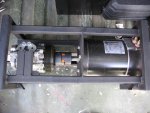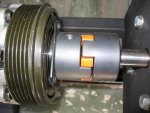Keith_J
Well-known member
- 3,657
- 1,328
- 113
- Location
- Schertz TX
FINALLY finished the project started in 2012, AC for my 1031. Basically, a large 24 volt DC motor is driving a Sanden SD7B10 compressor direct drive. The condenser is mounted conventionally, using the engine cooling fan and the evaporator is a small under dash unit. Aside from 2 holes in the frame rail and the holes for the refrigerant lines, there is little modification to the vehicle.
Yes, you CAN see the load on the voltmeter, it stays in the 12.8 volt range when on, the compressor cycles based on evap temp alone. I guess it is a few ounces shy so it gets pretty cold at the EX valve which is where the thermostat resides.
There is some belt squeal at low RPM, the engine needs new belts. I'm running dual purpose 27 marine/cranking batts so they can tolerate the cycling but an additional voltage cutout for the AC would be wise as to not run the voltage into the red.
Here is the compressor-motor. Yes, that is a Lovejoy type coupling. I took the compressor clutch apart, using only the hub. The rivet holes were then used to drill a mating pattern on the half of the coupling, then these were threaded 1/4-24 TPI and the hub was bolted to the coupling half.
Yes, you CAN see the load on the voltmeter, it stays in the 12.8 volt range when on, the compressor cycles based on evap temp alone. I guess it is a few ounces shy so it gets pretty cold at the EX valve which is where the thermostat resides.
There is some belt squeal at low RPM, the engine needs new belts. I'm running dual purpose 27 marine/cranking batts so they can tolerate the cycling but an additional voltage cutout for the AC would be wise as to not run the voltage into the red.
Here is the compressor-motor. Yes, that is a Lovejoy type coupling. I took the compressor clutch apart, using only the hub. The rivet holes were then used to drill a mating pattern on the half of the coupling, then these were threaded 1/4-24 TPI and the hub was bolted to the coupling half.
Attachments
-
72.2 KB Views: 325
-
75.3 KB Views: 260




 .
. . So, more work ahead.
. So, more work ahead.